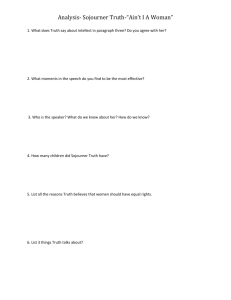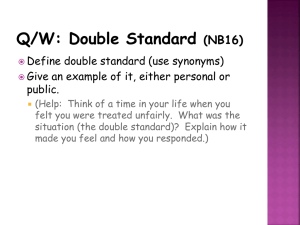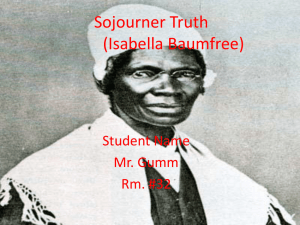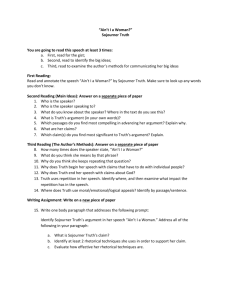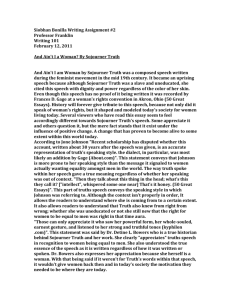Sojourner School Sojourner Mission
advertisement
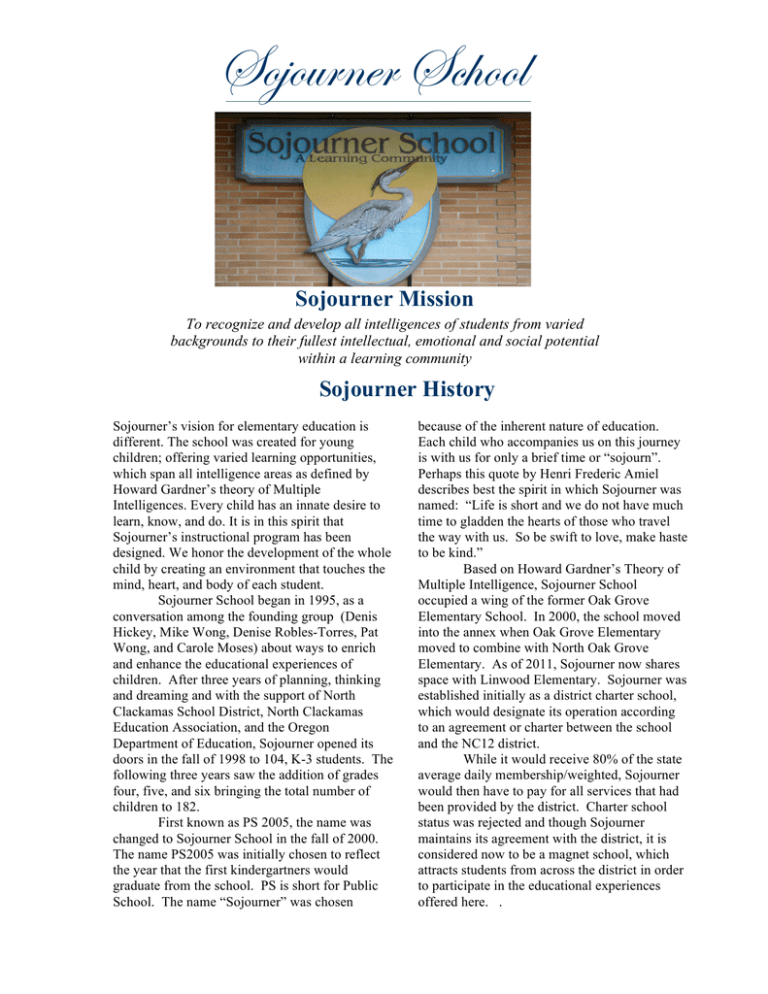
Sojourner School Sojourner Mission To recognize and develop all intelligences of students from varied backgrounds to their fullest intellectual, emotional and social potential within a learning community Sojourner History Sojourner’s vision for elementary education is different. The school was created for young children; offering varied learning opportunities, which span all intelligence areas as defined by Howard Gardner’s theory of Multiple Intelligences. Every child has an innate desire to learn, know, and do. It is in this spirit that Sojourner’s instructional program has been designed. We honor the development of the whole child by creating an environment that touches the mind, heart, and body of each student. Sojourner School began in 1995, as a conversation among the founding group (Denis Hickey, Mike Wong, Denise Robles-Torres, Pat Wong, and Carole Moses) about ways to enrich and enhance the educational experiences of children. After three years of planning, thinking and dreaming and with the support of North Clackamas School District, North Clackamas Education Association, and the Oregon Department of Education, Sojourner opened its doors in the fall of 1998 to 104, K-3 students. The following three years saw the addition of grades four, five, and six bringing the total number of children to 182. First known as PS 2005, the name was changed to Sojourner School in the fall of 2000. The name PS2005 was initially chosen to reflect the year that the first kindergartners would graduate from the school. PS is short for Public School. The name “Sojourner” was chosen because of the inherent nature of education. Each child who accompanies us on this journey is with us for only a brief time or “sojourn”. Perhaps this quote by Henri Frederic Amiel describes best the spirit in which Sojourner was named: “Life is short and we do not have much time to gladden the hearts of those who travel the way with us. So be swift to love, make haste to be kind.” Based on Howard Gardner’s Theory of Multiple Intelligence, Sojourner School occupied a wing of the former Oak Grove Elementary School. In 2000, the school moved into the annex when Oak Grove Elementary moved to combine with North Oak Grove Elementary. As of 2011, Sojourner now shares space with Linwood Elementary. Sojourner was established initially as a district charter school, which would designate its operation according to an agreement or charter between the school and the NC12 district. While it would receive 80% of the state average daily membership/weighted, Sojourner would then have to pay for all services that had been provided by the district. Charter school status was rejected and though Sojourner maintains its agreement with the district, it is considered now to be a magnet school, which attracts students from across the district in order to participate in the educational experiences offered here. . Sojourner Program Elements In addition to daily instruction in the traditional core areas of reading, writing and mathematics, Sojourner students participate in the following core elements; Violin All students learn to play the violin with Suzuki instruction. Students participate in classes three times per week in groups of thirteen students. Orff Sojourner Philosophy Sojourner believes that education must be comprehensive; addressing the development of the whole child: the intellectual, physical, ethical, and emotional. We recognize that all children are unique individuals requiring unique learning plans. To accommodate the varied needs, learning rates, and profiles of students, Sojourner has developed a comprehensive educational program. Sojourner also provides diverse learning opportunities through a variety of instructional models to foster understanding of our self and our world. Students are offered opportunities to build upon strengths to develop all other areas and to initiate influence and responsibility in their own educational development plans. Carl Orff (1895-1982) was a German composer and educator who developed a unique approach to music education. Orff defined the ideal music for children as "never alone, but connected with movement, dance, and speech—not to be listened to, meaningful only in active participation." Orff said, "Experience first, then intellectualize." Based on this ideal, the Orff approach builds understanding of concepts and skills through connecting students with the music by experiencing it on all levels. These levels include speech/chants, movement, singing, drama, and by playing pitched and unpitched instruments. Flow Dr. Mihaly Csikszentmihalyi’s theory of “flow” is a study on intrinsic motivation; where a person’s level of interest or motivation is directly aligned with the level of challenge. The Flow center is designed to offer students a children’s museum-style Exploratorium. Selected activities in each of the eight intelligences (visual/spatial/ verbal/linguistic, musical, mathematic/logical, bodily/kinesthetic, naturalistic, interpersonal, and intrapersonal) are designed and developed and offered as in-depth learning experiences. PODS Pods are interest groups composed of mixed aged groups (Early primary - Intermediate) where children can explore a common interest in great depth. Students choose from over a dozen broad subject areas that incorporate the multiple intelligence areas and include such subject areas as musical composition, gardening, geocaching, ultimate Frisbee, running, jewelry making, recycling, map making, chess, and the highly popular musical theater. This pod puts on a professional caliber production each year. Pods take place three times throughout the school year. They are held for 45 minutes, three times weekly and last from eight to ten weeks. Second Language At present Sojourner utilizes a Fles (foreign language in Elementary School) program . This is a nonimmersion in which students receive a minimum of 90 minutes of Spanish class per week. The goal is to build receptivity to the language by laying new neuronal networks and for students to begin to attain fluency. Bodily Kinesthetic Sojourner's core curriculum is committed to physical fitness as it relates to bodily-kinesthetic intelligence. A key indicator of the commitment to kinesthetic intelligence is the Presidential Physical Fitness results. Students participate in 30 minutes of exercise and community building every morning at the start of the school day. In addition, children have 30 minutes of physical education each week, focused on skill building and team sports. Character Education Sojourner students participate in daily community meetings aimed to build community spirit, empathy, and compassion. Students share stories, life experiences, talents with the whole community on a daily basis. A mentor system is built into the school whereby Intermediate students are “buddies” to their primary peers, helping them to learn and practice friendship, responsibility and compassion. Projects Every student completes an in depth, independent project each semester. All projects tie to a schoolwide theme, but each student chooses a topic based on his/her own interest. The 2013/14 school year theme is Transformation Project work encompasses three elements: a journal, a product and a presentation. Each presentation is filmed and sent home for the family to review. All project presentations are archived and, upon graduation from Sojourner, each student is given a collection of fourteen filmed project presentations. Multiple Intelligences Theory Dr. Howard Gardner, professor of education at Harvard University, developed the theory of multiple intelligences in 1983. It suggests that the traditional notion of intelligence, based on I.Q. testing, is far too limited. Instead, Dr. Gardner proposes eight different intelligences to account for a broader range of human potential in children and adults. These intelligences are: Linguistic intelligence Logical-mathematical intelligence Spatial intelligence Bodily-Kinesthetic intelligence Musical intelligence Interpersonal intelligence Intrapersonal intelligence Naturalist intelligence Dr. Gardner says that our schools and culture focus most of their attention on linguistic and logical-mathematical intelligence. We esteem the highly articulate or logical people of our culture. However, Dr. Gardner says that we should also place equal attention on individuals who show gifts in the other intelligences: the artists, architects, musicians, naturalists, designers, dancers, therapists, entrepreneurs, and others who enrich the world in which we live. One of the most remarkable features of the theory of multiple intelligences is how it provides eight different potential pathways to learning. If a teacher is having difficulty reaching a student in the more traditional linguistic or logical ways of instruction, the theory of multiple intelligences suggests several other ways in which the material might be presented to facilitate effective learning. Armstrong, Thomas. Multiple Intelligences in the Classroom. Alexandria, VA: ASCD, 1994. Admissions Sojourner School’s educational program is aligned with the theory of Multiple Intelligences. We seek families who are willing to make a strong commitment to the education of their children and who share the values and aspirations expressed in Sojourner’s mission, goals, and instructional program. Application to Sojourner is accepted from all students within the North Clackamas School District. Due to staffing levels and facility capacity, enrollment is limited to approximately 186 students. Sojourner conducts an open admissions protocol based on a lottery format. The community values diversity and admits students regardless of race, ethnic origin, or religion. The admissions cycle begins in the spring of each year, with a mandatory informational meeting held in April. Math Program Sojourner teachers use the National Council of teachers of Mathematics (NCTM) focal points to ensure that developmentally appropriate content is taught at all levels. The focus is on developing deep conceptual understanding rather than attempting to “cover” curriculum. Students use manipulatives to develop ideas at a conceptual level before moving to more abstract representations. Students are regularly asked to search for multiple solutions and to talk through their strategies, as well as to listen to the strategies of their peers. They practice questioning strategies to help them to develop clarity around a concept. Teachers use math tasks that present questions that are engaging to students in order to make mathematics relevant to every day life. Periodic Math nights provide opportunities for parents to come to school and learn math the way that their children are learning. The atmosphere is accepting and inviting to questions and concerns that parents have about supporting their children at home. Other program elements critical to Sojourner’s success include: Violin Loan Program Thanks to a grant through which Sojourner obtained a supply of violins, the students are able to check out a violin for a week at a time to practice at home. This program is made possible because of the hard work of our volunteer parents. Marimba Sojourner Intermediate students (4thand 5h) participate in an after school marimba program. The instructor volunteers her time to teach approximately 40 students and to prepare them for performances for such audiences as Wieden and Kennedy, the Children’s Museum, the Milwaukie Daze Parade. For the past two years, the Sojourner marimba group, Mananga, has created a professionally recorded CD to share with the community. Opening Each morning the Sojourner student body assembles for 30 minutes of exercise (aerobics, yoga, strength building, stretching) led by a partnership between the school’s director and a professional dance teacher. Following the exercise, students participate in an all school community meeting. There are multiple agenda topics (character education, school-wide schedule, student performance goals, guests, celebrating individual successes, birthdays, etc.) at these meetings. Character education topics, skits, celebrations, and discussions are the mainstay of the community meetings. Mentorships/Buddies Each Primary students (K and 1st) are paired with intermediate students as “buddies in a school wide mentorship program. Our older students assume the position of role models, and mentors, working with their buddies each morning during exercise, and at multiple school wide events. Community Sojourner school has an incredibly dedicated group of volunteers. With a student population of approximately 186, it is the smallest elementary school in the North Clackamas School District. During the 2007/08 school year, Sojourner boasted 9,830 volunteer hours. This is a ratio of 54 volunteer hours per student, and included a total 163 volunteers. Sojourner parents organize the school’s two major fundraisers, the Jog-a thon and the annual auction. These events raise funds critical to the implementation and success of most of Sojourner’s program elements. On any given day, you will find multiple volunteers throughout the school. These dedicated parents and grandparents help to make up the fabric of a service oriented, family atmosphere throughout the school. The Sojourner vision statement, A Learning Community, refers to an environment in which all members recognize one another as learners. Members share the responsibility of creating a culture dedicated to learning, respect, and achievement. Research establishes that parent involvement has a positive impact on student’s academic achievement, behavior, and attitudes toward school and work. We believe that when parents become school partners, the results can be significant and enduring.
